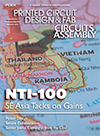THIEF RIVER FALLS, MN – Digi-Key Corp. has signed a deal to distribute the integrated antenna
product line of Cambridge,
UK-based Antenova
Ltd. Digi-Key will sell the products globally.
Antenova's radio antenna modules and other products are used in wireless applications such as mobile handsets, portable devices and other consumer electronics.
Antenova products are available for purchase directly from
Digi-Key and are featured in its print and online catalogs.
In a statement, Digi-Key president and COO Mark Larson said, “ “We are very excited to add this innovative company to our line card. I am certain that the rapid design and ease of use benefits of Antenova’s products will be of consequential interest and appeal to our customers.”
“Antenova is proud to be working with Digi-Key to further grow our customer base,” said David Nuti, North American sales manager for Antenova. “This agreement underpins our commitment to providing the best integrated antenna solutions and support to our global handset, portable device and laptop computer customers and partners.”
In a joint effort to improve supplier collaboration, Microsoft and Intel announced proposals for the next-generation of open, interoperable business standards for small-to-medium enterprise supplier collaboration, based on the Office Open XML formats.
Under the management of the open standards body Ecma International, the Open XML document formats are now being finalized as a worldwide standard by leading tech companies including Intel. The document format standard offers flexible support for integration external XML information, which is critical to RosettaNet requirements.
Also announced was the establishment of a customer advisory board composed of companies representing various market segments, including Applied Materials, Flextronics, Juniper Networks, Nvidia, Xilinx and others.
The one-hour online event takes place Oct. 3, at 9 and 3 EST.
Topics to be covered include the company's Ultiboard interface, advanced routing and placement, managing design constraints, exporting industry standard formats and more. To register, visit http://www.electronicsworkbench.com/news/pronews3b.html.
Plans call for a 26,300-sq. ft., two-story facility to be located adjacent to the company’s headquarters.
IC Packaging & Test Roadmaps: Device Trends Impact on Packaging & Test Technology and Supply Chain, the annual roadmap symposium, will overlay IC device trends with the associated current and future technology solutions for packaging and test and will also explore challenges associated with demands for full turnkey supply chain services.
For more information, visit www.meptec.org.
Press Releases
- Innominds and SIIX launch SIIX-Innominds JV to offer full-stack ODM services in India
- Syrma SGS Technology, Ltd to Accelerate AI-Driven Manufacturing with implementation of analytics and AI solution from Arch Systems in partnership with NMTronics India
- TTCI and The Training Connection Strengthen Electronics Manufacturing with Test Services and Training at PCB West 2025
- SMTA “Members of Distinction” Awards Announced


